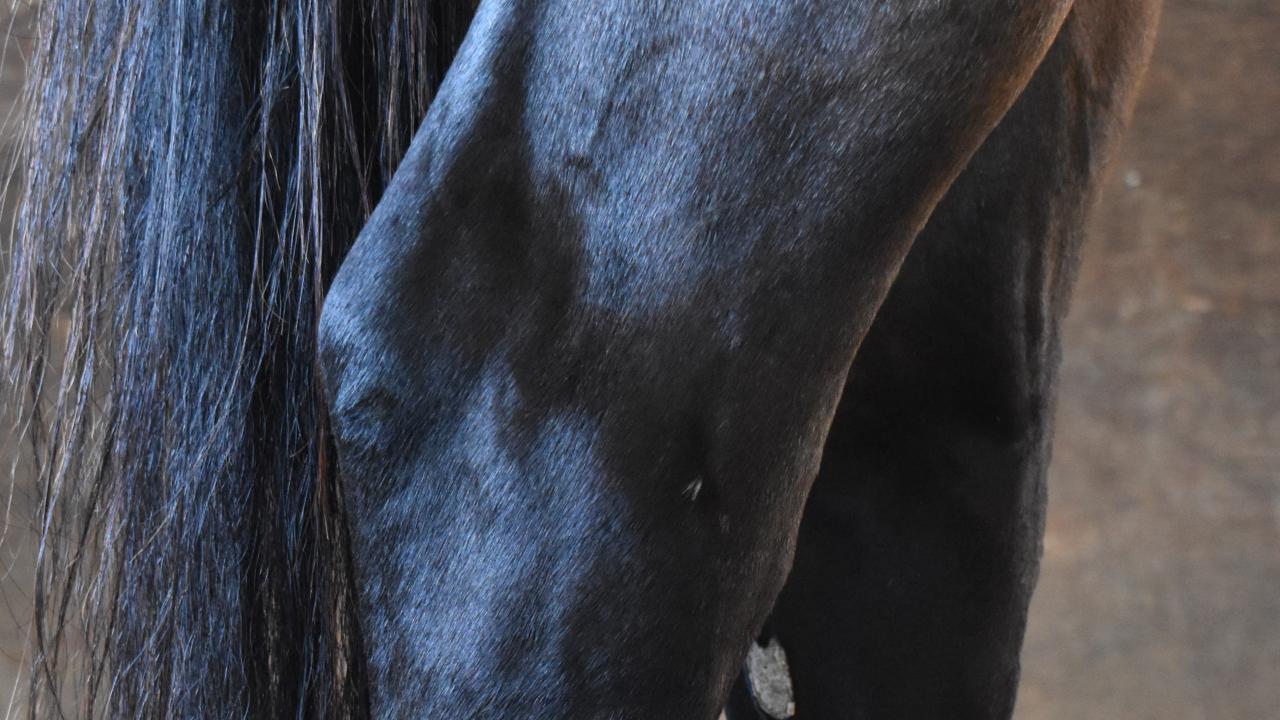
Osteochondritis Dissecans (OCD)
What is osteochondritis dissecans?
Takeaways
- Osteochondritis dissecans (OCD) is a joint disease in young horses in which cartilage fragments detach from bone surfaces.
- Hocks, stifles and fetlocks are the joints most affected with OCD. Other joints may be affected as well.
- Risk factors for OCD include rapid growth, body size, nutrition, genetics, and trauma.
- Some horses show no clinical signs of OCD, whereas others may exhibit joint swelling and lameness that require surgery.
- Prognosis varies depending on the location and severity of the lesion, but many horses respond well to treatment.
- Early diagnosis and treatment offer the best chance for full recovery and return to performance.
Osteochondritis dissecans (OCD) is a joint condition seen in young horses that results from abnormal cartilage development. It is considered an advanced form of osteochondrosis (OC), which occurs when the blood supply to growing cartilage is disrupted. In some cases, the cartilage heals on its own. In others, it deteriorates and fragments– commonly known as “OCD chips” - can detach from the surface of the bone. These chips can cause inflammation, joint pain, and may lead to osteoarthritis (degenerative joint disease) if left untreated.
Osteochondritis dissecans can affect any joint, but most commonly occurs in fast-growing joints such as fetlocks, hocks, shoulders, and stifles. It can develop on both sides of the body (for example, both hocks), but severity can differ between limbs.
This condition develops during the first few months of life, when foals are growing rapidly. As horses age, the ability to heal cartilage declines. Most lesions that do not resolve on their own are identified by 12 to 18 months of age.
Risk factors include rapid growth, large body size, nutrition, genetics, and trauma. It is more common in large breeds such as Thoroughbreds, Standardbreds, and warmbloods and less common in ponies.
What are the clinical signs of osteochondritis dissecans?
Clinical signs of OCD vary depending on the joint affected and the horse’s age. Affected foals often spend an excessive amount of time lying down and may exhibit joint swelling, stiffness, and upright limb conformation.
Some horses, especially those with moderate lesions, may not exhibit clinical signs of OCD until they are in training. At this stage, they may exhibit joint swelling, joint pain, stiffness, reduced range of motion, or lameness, which often result in reduced performance.
How is osteochondritis dissecans diagnosed?
Osteochondritis dissecans is diagnosed through a combination of clinical examination and imaging. The horse’s age, breed, and medical history are considered. Radiographic evaluation of the affected joints is the primary method of identification. Ultrasound may identify OCD lesions as well but is less commonly used.
Many horses are diagnosed on routine screening radiographs of the joints and do not have any overt clinical signs.
How is osteochondritis dissecans treated?
Treatment for OCD depends on the location and severity of the lesion, as well as the horse’s age and intended use. It often includes stabilizing the joint to prevent further cartilage damage through rest and limited exercise.
For young horses with mild lesions and no clinical signs, treatment may include rest, regular monitoring with radiographs, joint injections to manage joint inflammation, and pain management as needed.
Horses with more severe lesions and exhibiting lameness often require arthroscopic surgery, a minimally invasive procedure to remove loose cartilage fragments and smooth the joint surface. In some cases, therapies such as stem cells, platelet-rich plasma (PRP), and other advanced biologics may be used to support healing after surgery.
What is the prognosis for horses with osteochondritis dissecans?
Many horses treated for OCD return to performance, especially with early diagnosis and surgery. The prognosis depends on the site and severity of the lesion but is generally considered good in young horses without secondary problems to the affected joint.
Horses with mild lesions often have an excellent prognosis and may return to training several months after surgery. Lesions involving joint instability or osteoarthritis have a more guarded prognosis, particularly for high-level performance but can have positive outcomes.
Early identification and treatment of horses with surgical OCD lesions improves the prognosis and long-term outcomes.
How can osteochondritis dissecans be prevented?
Although OCD can’t always be prevented, growth and nutrition management in the first months of life can reduce risk. High energy (high carbohydrate) feed and an associated rapid growth rate, as well as dietary mineral imbalances, are known risk factors for OCD.
Recommendations to reduce risk include feeding a balanced, low-starch, low-sugar diet, avoiding overfeeding or excessive energy intake, and ensuring mineral balance in diets (especially calcium, phosphorus, copper, and zinc). Work with a veterinarian or equine nutritionist to optimize the feeding program for each horse.
For more information
UC Davis, School of Veterinary Medicine, Equine Surgery and Lameness Service
